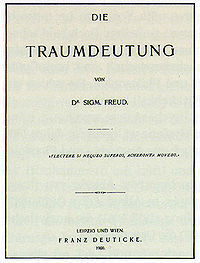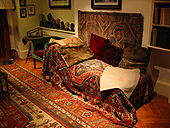- The Interpretation of Dreams
-
For the 1990 documentary film, see Interpretation of Dreams (film).
The Interpretation of Dreams 
Cover of the original German edition.Author(s) Sigmund Freud Original title Die Traumdeutung Translator first version A. A. Brill; officially replaced by James Strachey Country Germany Language German Publisher Franz Deuticke, Leipzig & Vienna Publication date 1899 Published in
English1913 (Macmillan, translation of the German 3rd edition) The Interpretation of Dreams is a book by psychoanalyst Sigmund Freud. The first edition begins:
In the following pages, I shall demonstrate that there exists a psychological technique by which dreams may be interpreted and that upon the application of this method every dream will show itself to be a senseful psychological structure which may be introduced into an assignable place in the psychic activity of the waking state. I shall furthermore endeavor to explain the processes which give rise to the strangeness and obscurity of the dream, and to discover through them the psychic forces, which operate whether in combination or opposition, to produce the dream. This accomplished my investigation will terminate as it will reach the point where the problem of the dream meets broader problems, the solution of which must be attempted through other material.
[1].
The book introduces Freud's theory of the unconscious with respect to dream interpretation. Dreams, in Freud's view, were all forms of "wish fulfillment" — attempts by the unconscious to resolve a conflict of some sort, whether something recent or something from the recesses of the past (later in Beyond the Pleasure Principle, Freud would discuss dreams which did not appear to be wish-fulfillment). However, because the information in the unconscious is in an unruly and often disturbing form, a "censor" in the preconscious will not allow it to pass unaltered into the conscious. During dreams, the preconscious is more lax in this duty than in waking hours, but is still attentive: as such, the unconscious must distort and warp the meaning of its information to make it through the censorship. As such, images in dreams are often not what they appear to be, according to Freud, and need deeper interpretation if they are to inform on the structures of the unconscious.
Freud begins his book in the first chapter titled The Scientific Literature on the Problems of the Dream by reviewing different scientific views on dream interpretation, he finds them interesting but not adequate [2]. He then makes his argument by describing a number of dreams which he claims illustrate his theory. Many of his most important dreams are his own — his method is inaugurated with an analysis of his dream "Irma's injection" — but many also come from patient case studies. Much of Freud's sources for analysis are in literature. Freud here also first discusses what would later become the theory of the Oedipus complex.
The initial print run of the book was very low — it took many years to sell out the first 600 copies. Freud revised the book at least eight times, and in the third edition added an extensive section which treated dream symbolism very literally, following the influence of Wilhelm Stekel. Later psychoanalysts have expressed frustration with this section, as it encouraged the notion that dream interpretation was a straightforward hunt for symbols of sex, penises, etc. (Example: "Steep inclines, ladders and stairs, and going up or down them, are symbolic representations of the sexual act.") However, Freud repeatedly argued that he never claimed anything of the sort, and felt compelled to address this simplistic interpretation of his work in the fifth edition of the book (1919):
The assertion that all dreams require a sexual interpretation, against which critics rage so incessantly, occurs nowhere in my “Interpretation of Dreams.” It is not to be found in any of the numerous editions of this book and is in obvious contradiction to other views expressed in it. (The Interpretation of Dreams, fifth edition, 1919, Chapter VI, Section E, translated by James Strachey, 1953) Freud said of this work, "Insight such as this falls to one's lot but once in a lifetime."[3] This book was translated from German into English by Dr. A.A. Brill an American Freudian psychoanalyst, and later in an authorized translation by James Strachey, who was British. Because the book is very long and complex Freud wrote an abridged version called On Dreams.
Some authors, such as Hans Eysenck have argued that the dreams Freud cites do not really support his theories. Eysenck argues in Decline and Fall of the Freudian Empire that Freud's examples actually disprove his dream theory.
References
Part of a series of articles on Psychoanalysis Important figuresAlfred Adler · Michael Balint
Wilfred Bion · Josef Breuer
Nancy Chodorow · Erik Erikson
Ronald Fairbairn · Sándor Ferenczi
Anna Freud · Sigmund Freud
Erich Fromm · Harry Guntrip
Karen Horney · Ernest Jones
Carl Jung · Melanie Klein
Heinz Kohut · Jacques Lacan
Ronald Laing · Margaret Mahler
Otto Rank · Wilhelm Reich
Harry Stack Sullivan
Susan Sutherland Isaacs
Donald WinnicottImportant worksSchools of thoughtPsychology portal

